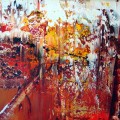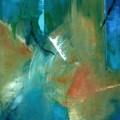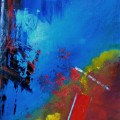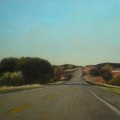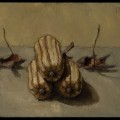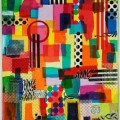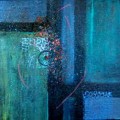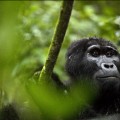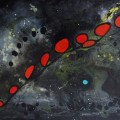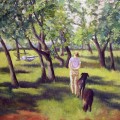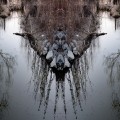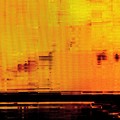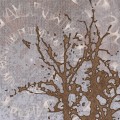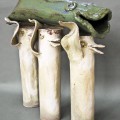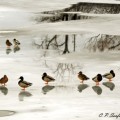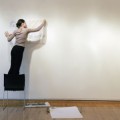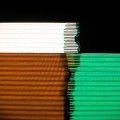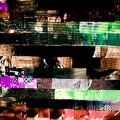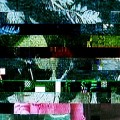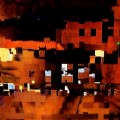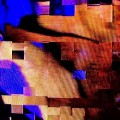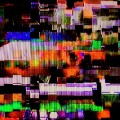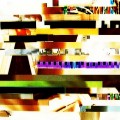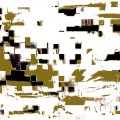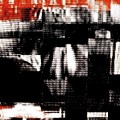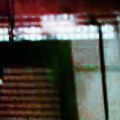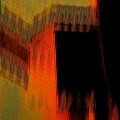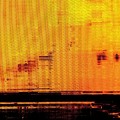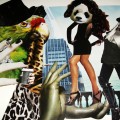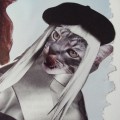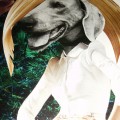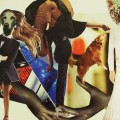“Abstracts from Nature,” a solo show of recent paintings by Ethel Vrana opens June 2, 2010, at State of the Art Gallery. The paintings in this show represent a change for the artist; in the past few years, her work has evolved from landscape to abstract painting. Vrana states: “Whether I paint realistic landscapes or abstract paintings I try to capture the beauty of nature in all its forms, colors and light.” She explains that her abstract work involves experimental techniques and materials new to her and she has enjoyed the aesthetic challenges her new way of working has presented. Vrana studied at the University of Rochester where she received her B.S. degree in Fine Arts and Philosophy. She has taught art at Tompkins Cortland Community College and in the Trumansburg Central Schools and the Trumansburg Conservatory of Fine Arts. Vrana has been a member of State of the Art since 2008. This is her first solo show at the gallery. For more about Ethel and to see more of her work, please visit www.ethelvrana.com
Category: Uncategorized
May Members Show
City Streets

During April, “City Streets” a show of paintings by Erica Pollock will be at State of the Art. About her work, the artist states: “I focus on the urban environment as my subject matter, which is emphasized by the use of light and shadow. In my most recent work, the interaction between people, shadow and streets is explored. By cropping the physical elements, such as people or cars, the focus of the painting is pulled into the shadows, exploring the shadows as a reflection of the physical person.” Show dates: March 31-May 2, 2010. Reception for the artist, Friday, April 2, 5-8pm. Gallery hours: Wed.-Fri., 12-6pm and Sat. & Sun., 12-5pm. 120 W. State Street. Info: 607-277-1626, www.soag.org// The gallery is ADA accessible with curbside parking.
Comments from Steven Skopik 21st Annual Photo Show
Steven Skopik
Associate Dean for Faculty
Department of Cinema, Photography and Media Arts
Ithaca College
When I visited the gallery to look at the Sate of the Art gallery’s current photography exhibition, I was immediately taken with the scope of the work on the walls. Photographs are endlessly compelling because they have so many cultural uses—informational (in the cases of documentary and journalism), rhetorical (to the extent that some photos assert opinions and conduct implicit or overt arguments), and aesthetic (since yet other photographs explore more aesthetic avenues of expression). Along those lines, bestowing a “best of the show” award—or a first, second, and third prize–presents a daunting challenge. To indulge the cliché, selecting a wining image (or images) would be to compare apples and oranges, and would likely have as much to do with telegraphing the idiosyncratic tastes of the juror, as reflecting the intrinsic worth of the work. Thus, I’ve elected to honor equally five images that for me stand as particularly successful exemplars of their type, affirming the fascinating variety of approaches to photography seen in the exhibition.
In no hierarchical order, then, other than the convenience of taking you through the gallery from front to back, I’d begin with Kristina Heisey’s image titled “Abrosia.” Ms. Heisey’s picture is striking on a number of levels. Certainly the picture is visually arresting. With its super-saturated, nearly neon-bright swirl of color, the photograph provides a can’t-miss-it-from-across-the room, amped-up visual punch. I’m often fond of employing food analogies in the discussion of visual work–perhaps appropriate, given the piece’s title. If this whirling blob of plasma had a texture and taste, I imagine it would possess the chewy tang of Starbursts candy. (For those who haven’t had the pleasure, imagine saltwater taffy infused with a sour fruitiness whose intensity owes less to flavors found in nature than some diabolical lab experiment–wholly invented, but intensely pleasurable.)
Lurking below the playful allure of Ms. Heisey’s image is an interestingly confounding problem. The picture is almost completely abstract. So distorted or transformed is the physical object or process pictured, that at least on first consideration, it could just as easily have been painted, or executed as a computer drawing–rendered in a painting program of one sort or another. In this sense, the piece asks some rather basic questions. What is this thing? Is it even a photograph at all? Does the answer really matter?
For me, the easy-to-overlook detail that nudges the image into the realm of the photographic is the discovery that the picture rewards very close inspection. Like a conventional photograph that offers up greater and greater detail the more minutely one inspects it (this is arguably one of the medium’s most essential attributes), beyond an initial encounter with the image’s loud colors and emphatic motion effects, close scrutiny of “Ambrosia” reveals minute and subtle details. For example, one sees an intricate, thread-like moiré effect, hints of order and structure. The piece is, then, is something of an “anti-photographic” photograph.
A piece that similarly employs photography towards conceptual ends is Randi Millman Brown’s “Deaccessioned.” To deaccession is to remove an artwork from a museum’s collection. The term has a specific meaning in a professional context, but it also summons up associations of faded value, obsolescence, and abandonment. When I hear the term deaccession, I can’t help but think of rusted-out, discarded naval vessels. Deaccessioned. Decomissioned. Gone. Kaput. Over.
Milman’s diptych reproduces a grid of slides of well-known paintings. A moment’s consideration suggests that it cannot be the actual canonical works that are to be taken out of commission. Rather it is the film-based slides themselves that are likely being discarded. Thus, the piece stands as something of an elegy for the passing of a certain kind of image making—the photograph in its tangible, analog incarnation.
A lot has been written regarding the photograph’s resonance with mortality and the transitory. After all, any photograph presents a vivid description of something (or someone) that is irretrievably remote in both space and time. The piece “Deassession” is, I think, a kind of double lament. It can’t help but acknowledge the photograph’s characteristic commerce with time, memory, and ephemerality, and it extends that sense of loss to a consideration of the medium itself.
In Susan Larkin’s “Monkshood” we see in an image whose allure is less cerebral than it is frankly sensual. Evoking the early twentieth century German photographer Albert Renger-Patchz, who similarly trained his camera on a range of different types of plants, usually withered and pictured against a blank background, Ms. Larkin’s picture meticulously describes her subject in a manner that grants it a delicious availability.
In contrast to Kristina Heisey’s image, which as mentioned tends to refute it’s own status as a camera-made picture, the appeal of Larkin’s piece is rooted in a quintessentially photographic effect. The photograph, more than any other type of representation, is able to offer forth its subject with a strange, urgent sense of “therenesss.” Larkin achieves this odd hyper-present effect through the use of razor-sharp focus, and her photo’s richly detailed tonal description of the withered stalks and pods. The plants have an astonishing luminous quality; they appear to radiate light, rather than reflect it. The net effect is to imbue these modest objects with an unaccountable sense of poised significance.
Finally, it must be said, that despite their husk-like state of desiccation, the plants possesses a vivid sensuality. No doubt this is in part due to the picture’s formal attributes (just described), but it also has to do with the subject matter, which summons up associations with life, death, and reproduction and renewal. I’m not familiar with this particular species, but I assume we’re looking at seed vessels of some sort. To declare that this is an erotic photograph is merely to state the facts; Larkin allows us to look lingeringly on the genitals and reproductive apparatus of a living–or once living– organism. Intended in an entirely complementary manner, this image is the exhibition’s most overtly lurid photograph.
Moving on to Myron Walter’s “Genoa Feed Mill” we see an image whose expressive register is less purely descriptive than it is poetic. On first consideration, one cannot think of a less promising occasion for aesthetic of contemplation. The photograph records a prosaic conglomeration of metal grain silos and a truck, all situated in a rutted, dreary roadside locale. (Ah, winter in central New York State!)
The achievement of a picture like this one is that it manages to somehow dignify and transcend it’s debased subject matter. Mr. Walter’s accomplishes this by sensitively noticing elements in the scene that possess an intrinsic expressive potential. For example, the photograph wouldn’t have nearly the sense of weighty foreboding that it does were it not for the roiling, moody clouds that dominate the top of the frame. Beyond skillfully noticing and recording what’s there, Mr. Myron employs first-rate photographic craft to exaggerate and transform. The subject matter is utterly banal and forlorn, but the photographer’s careful manipulation of objects’ contrast and tonal qualities imbue them with an unexpected beauty and dignity. Actual tanker trucks and grain mills don’t in real life glow with the freaky gorgeousness of these particular agro-objects. Thus, the piece is both document and impressionistic interpretation, compellingly balancing actuality and expressive artifice.
Finally, I would single out for discussion Donald Specker’s “Deer Patrol.” Mr. Specker achieves an effect in this photograph that is very difficult to pull off—he records a scene that at first blush is engagingly whimsical, but that on further reflection takes on an edge of anxiety and menace. The picture presents an unremarkable, well-kept ranch-style tract home. There is nothing distinctive about the structure, and presumably about the lives within. One imagines that the occupants drive a domestic automobile, look dutifully after their 2.5 children, shop at Tops (not Wegman’s), and pay the mortgage on time. The image’s element of interruption, of course, is provided by the three deer, whose precise, equidistant positioning left to right in the frame comes off as somehow too perfect. This tends to lend the picture an unexpected and winning sense of artifice. It’s as though we’re seeing not a documentary moment, but an intentionally set-up tableau. I realize that the picture was likely noticed on the fly, but it has an unexpected quality of inevitability. It’s as though the scene has been crafted by a movie director, the deer provided and marched through the frame by an animal wrangler, just off frame.
The feel of submerged menace in the picture comes about for a number of reasons. The deer represent an element of potential disorder in an otherwise resolutely domestic scene. Deer are not lions or tigers, but they are big, sometimes unpredictable animals. Certainly they’ll ruin your day if they jump through your plate glass living room window, or worse, the windshield of your car at sixty miles per hour. Or, if that’s a bit too dramatic, the animals represent an intrusion, an upset to the tidy residential domesticity that otherwise dominates the scene. Depending on your proclivities, this may be either exhilarating or worrisome.
Again, my thanks to State of the Art for allowing me to honor and comment on some of the work in its exhibition. I’ll look forward to revisiting the gallery and thinking further about the many excellent, engaging pieces on view.
Brief Biography of Steven Skopik
STEVEN SKOPIK (M.F.A. Rhode Island School of Design, M.A. University of Wisconsin-Madison, B.A. University of Delaware) has exhibited photographic work in numerous solo and group exhibitions throughout the United States. His articles, essays, and reviews on photography have appeared in such publications as exposure, Afterimage, and History of Photography. Professor Skopik has been awarded an Artist’s Fellowship from the New York Foundation for the Arts, and has twice been a recipient of a photographer’s grant from Light Work in Syracuse, New York.
skopik@ithaca.edu
March 5, 2010
21st Annual Juried Photography Show
Winners of the People’s Choice Award
2010 State of the Art Photo Show from Stan Bowman on Vimeo.
Kristine Heisey for “Ambrosia”
Randi Millman-Brown for “Deaccessioned”
Susan Larkin for “Monkshood”
Mryon Walter for “Genoa Feed Mill”
Donald Specker for “Deer Patrol”
Judge’s comments on Photography Show
$500 in prizes were awarded at a reception March 5 at 6:30pm by prize judge Steven Skopik of the Department of Cinema, Photography and Media Arts at Ithaca College. This year for the first time, the gallery will have a “People’s Choice Award” to be given away at the end of the show. Voting will be by ballot at the gallery only. That award will be $75.00.
This is a very popular exhibition in the region and it always garners top quality photographic images that range from traditional negative prints to digital work. Show dates are March 3-28, 2010. In conjunction with the exhibition is a special event at the gallery: “The Effect of Electronics on Art”. This will be a panel discussion among three artists about how the field of electronics has affected their artmaking and broadened the definition of what constitutes “art” on Wednesday, March 24 at 7pm. Panelists are: Tammy Renee Brackett of Alfred, NY, Assistant Professor of Digital Media and animation at Alfred State College; Rhonda Morton of Corning, NY, Founder of Alligator Mouth Improv; and John Criscitello of Ithaca, NY, founder of Video/Art/Ithaca. This event is free and open to the public.
“Private Shadows and Dreamscapes”
Wilson Jay Ong and Daniel McPheeters
February 12 – March 12, 2010
ARTISTS’ TALK & OPENING RECEPTION:
Friday, February 12, 5:30 – 8:00 PM
Talk, 5:30 – 6:00/ Reception, 6:00 – 8:00
HOUGHTON GALLERY
171 Cedar Arts Center
155 Cedar Street at East 1st St.
Corning, NY 14830
GALLERY HOURS:
M-Th. 9-7pm, Fri. 9-6pm, Sat. 9-2pm
James Spitznagel
Saints & Animals
Guidelines: Artists applying for membership in SOAG
The points below are stated to help artists applying for membership in the State of the Art Gallery understand how the process works. When reviewing new membership applications, the gallery strives to maintain a balance of styles and media. We also value persons who support the cooperative nature of the gallery and the responsibility of membership. We use the points in A-E as guides for discussion. They are not hard and fast rules. Rather, they give us a framework in which to discuss an applicant’s work. The decision, pro or con, is based on a simple majority of the current membership. It should be noted that a decision not to accept is sometimes accompanied by suggestions for future work with a hope that the applicant will re-apply after an appropriate period. In fact, several successful, current members have been through a similar process of applying more than once.
A. Originality/Vision
Is there something that makes this person’s work unique and/or memorable?
B. High Technical Craftsmanship
Does the work demonstrate skillful use of the media, good composition, use of color where applicable, value and form?
C. Seriousness of Purpose/Maturity/Record of Accomplishment
Is there consistency that distinguishes the work? Is there a record of exhibition/shows or other evidence of serious intent? Has the artist clearly expressed his/her ideas clearly and/or creatively?
D. Presentation of Work
Is the work framed/based/mounted in a professional way?
E. Commitment to the Mission of the gallery.
Has the applicant expressed knowledge of gallery member responsibilities and willingness to perform them? Is there an expectation of long-term membership and financial commitment?
Exhibitor Agreement
State of the Art Gallery
120 West State Street, Ithaca, New York 14850
607-277-1626
21st Annual Photo Show Exhibitor Agreement March 3-28, 2010
Please print clearly
Name of Exhibitor_____________________________________________________
Street Address________________________________________________________
City_______________________________ State______________ Zip___________
Telephone______________________E-Mail________________________________
Work(s) submitted: print clearly
Title Media Date Price
1.___________________________________________________________________
2.___________________________________________________________________
Exhibition Agreement
1. The exhibitor agrees to pay a $30.00 non-refundable fee upon submission of work.
2. The artist/exhibitor agrees to deliver their work(s) to the Gallery at the published date. and time. The exhibitor will abide by the rules of the gallery regarding presentation and suitability for hanging as stated in the Call for Entries. Final approval of the criteria is the responsibility of the Gallery Board of Directors.
3. The Gallery will provide an exhibition opening/reception for the artists with refreshments and an Award Ceremony. Exhibition announcements will be provided by the Gallery and mailed to the Gallery mailing list. Additional cards will be available for the personal use of the exhibitor, but the cost of mailing these additional cards is the responsibility of the exhibitor.
4. While the State of the Art Gallery, its members and agents, will make reasonable efforts to protect the work(s) of an exhibitor, the Gallery cannot indemnify the work(s) against loss or damage. In submitting and agreeing to exhibit the work(s) in the Gallery the exhibitor agrees that the State of the Art Gallery, its members, Board of Directors, or agents will not be held liable and will be held harmless should there be damage or loss of work(s).
5. The exhibitor agrees that the work(s) of the exhibitor may be reproduced for the purpose of advertising the exhibition for a period not to exceed five years.
6. It is agreed that the exhibitor may conduct sale of the work(s) from the exhibition. The Gallery will act as facilitator through it’s members who staff the Gallery during regular gallery hours. For the service, the Gallery receives a 30% commission on the sale of all displayed work.
7. The show ends Sunday, March 28. Work must be picked up between noon and 6 pm that day.
EXHIBITOR SIGNATURE______________________________________________DATE_______
GALLERY REPRESENTATIVE_________________________________________DATE_______
PHOTO Returned signature _____________________________________________DATE_______

